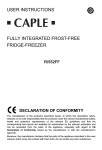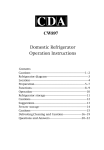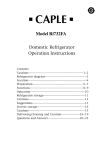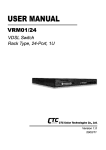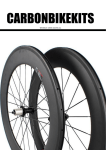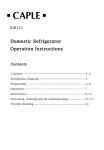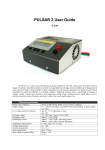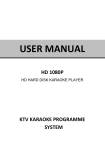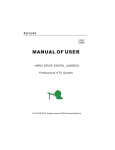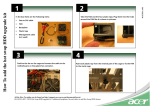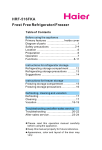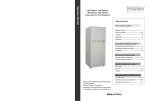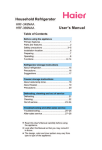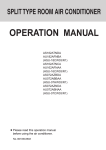Download Haier Refrigerator HRF-265F User's Manual
Transcript
11 IMPORTANT SAFETY INFORMATION Check that the voltage marked on the rating plate matches that of your local supply. Failure to use the correct voltage will render the guarantee VOID and may cause damage to the appliance. The manufacturer accepts NO responsibility for using any other voltage than that marked on the rating plate. This appliance is intended for domestic use only; any other use may invalidate the warranty and might be dangerous. This appliance is intended for indoor use only, do not use or store outdoors. This appliance shall not be exposed to rain. The mains plug shall be the main disconnect device and shall be operable at all times. A short power-supply cord is provided to reduce the risk of a tripping hazard. Do not immerse the appliance, its lead or plug in water or any other liquid. Remove all food and unplug from the supply when not in use and before cleaning the appliance. If the mains lead becomes damaged, it must be replaced by the manufacturer, its service agent or similarly qualified person with a specially prepared lead of the same type and rating to avoid a hazard. Do not operate the appliance with a damaged cord or plug or after the appliance malfunctions or has been damaged in any way. The mains plug shall be the main disconnect device and shall remain operable at all times. Do not let cord hang over edge of the surface, or touch hot surfaces. Do not place the appliance on or near hot surfaces, or in direct sunlight. Children must be supervised to make sure they do not swing on the door. Accessible surfaces may get hot when in use, use handles and knobs at all times. Always attach a plug to the appliance, and then plug it into the wall outlet and switch on. To disconnect from the mains completely, turn the appliance OFF, then remove the plug from wall outlet. If you are discarding an old appliance with a lock or catch fitted to the door, ensure that it is left in a disabled condition to avoid the entrapment of young children when playing. As old refrigeration equipment may contain CFC’s which will damage the ozone layer, when disposing of any refrigeration appliance please contact your local waste disposal department for advice on the correct method of disposal. This appliance is not intended for use by persons (including children) with reduced physical, sensory or mental capabilities, or lack of experience and knowledge, unless they have been given supervision or instruction concerning use of the appliance by a person responsible for their safety. Children should be supervised to ensure that they do not play on or near the appliance. This appliance is for refrigerating food and making ice cubes. REFRIGERANT The refrigerating gas contained in the circuit of this appliance is Isobutene (R600a); it causes a low level of pollution but is inflammable. CAUTION: Extreme caution must be used when moving the appliance. WARNINGS: Do not damage the refrigerant circuit. Do not use sharp or pointed objects such as knives to remove ice when defrosting. Do not use mechanical devices or other means to accelerate the defrosting process, other than those recommended by the manufacturer. Do not use electrical appliances inside the food storage compartments of the appliance, unless they are of the type recommended by the manufacturer. If the appliance is installed in a carpeted area, do not let the carpet block the ventilation holes in the base of the unit, adjust the levelling feet after a few hours to compensate for carpet movement. Keep ventilation openings, in the appliance enclosure or the built in structure clear of obstructions. 2 2 This Built in model-HRF-265F Installation instruction 3 Contents Cautions--------------------------------------------------------5~6 Refrigerator diagram-------------------------------------------7 Location------------------------------------------------------------8 Preparation--------------------------------------------------9~11 Functions---------------------------------------------------12~13 Operation-------------------------------------------------------14 Refrigerator storage------------------------------------------15 Cautions---------------------------------------------------------16 Suggestions-----------------------------------------------------17 Freezer storage-------------------------------------------18~19 Cautions---------------------------------------------------------20 Defrosting,Cleaning and Cesstion------------------21~24 Questions and Answers--------------------------------25~28 Disposal instruction------------------------------------------29 4 Cautions Disposal of the old appliance Before disposing an old appliance, please make sure it’s inoperative and safe. Unplug the appliance and remove or destroy all of the springs, latches, or bolt-locks in order to avoid the risk of child entrapment. It must be noted that the refrigeration system contains insulating gases and refrigerants, which require specialised waste disposal. The valuable materials contained in a refrigerator can be recycled. Contact your local waste disposal center for proper disposal of an old appliance and contact your local authority or your dealer if you have any question. Please ensure that the pipe work of your refrigerator dose not get damaged prior to being picked up by the relevant waste disposal center, and contribute to environmental awareness by insisting on an appropriate method of disposal. Disposal of the packaging of your new appliance All the packaging materials employed in the package of your new appliance may be disposed without any danger to the environment. The cardboard box may be broken or cut into smaller pieces and given to a waste paper disposal service. The wrapping foil is made of polyethylene and the polyethylene pads and stuffing contain no fluorochloric hydrocarbon. All these valuable materials may be taken to a waste collecting center and used again after recycling. Consult your local authorities for the name and address of the waste materials collecting centers and waste paper disposal services nearest to your house. Safety Instructions and Warnings Before starting the appliance, read the information given in the User’s Guide carefully. The User’s Guide contains very important instructions relating to the assembly, operation and maintenance of the appliance. Keep the User’s Guide in a safe place. The manufacturer does not accept responsibility for any damages that may arise due to non-observation of the following instruction. 5 5 C io s Caut Cautions aut autions *Damaged appliances are not to be put into operation. In case of doubt ,consult your dealer. *Connection and installation of the appliance are to be carried out in strict compliance with the relative instructions set out in the Use’s Guide. *For the purpose of safety ,the appliance must be properly grounded. *Power cable should only be replaced by factory authorised service agent. *Always remember to unplug the appliance before cleaning.To T disconnect the appliance, pull the plug itself not the cord. *Keep alcoholic beverages in airtight bottles or containers and always store in an upright position. In addition, do not store any explosive substances inside the appliance-Danger of explosion! *Do not damage any parts of the appliance that carry refrigerant by piercing or perforating the refrigerant’s grooves with sharp or pointed items,crushing or twisting any tubes, or scraping the coatings off the surfaces. *Do not obstruct or cover the ventilation grille of the appliance. *Do not allow children to play with the appliance. In no case should children be allowed to sit on the drawers or hang onto the door. *After installation of the appliance the plug should be easily accessible. *If the power cable is damaged, an approved cable of the same type and rating and should be replaced by a qualified service agent. *Warning: Keep the appliance well ventilated; remove any transport supports from cavity. *Warning: Do not use hard objects to remove frost. *Warning: Ensure the refrigeration pipeline cannot be damaged. *Warning: Do not use electric appliances within the food storage compartment except for models recommended by the manufacturer. WARNING: *This appliance is designed for food refrigeration, ice making and frozen food storage. *This appliance is intended for domestic use only,any other use may invaidate the warranty and might be dangerous. *The refrigerating circuit is leak-proof. * Make sure the cooling circuit is not damaged at any time, if it becomes damaged, unplug the appliance form the supply and seek expert advice. 6 Refrigerator Diagram This diagram may very slightly with the layout of the refrigerator you have just purchased due to manufacturer developments. 77 Location *The refrigerator should be placed on a flat and solid surface. If the refrigerator is placed on a plinth, flat, strong and fire-resistant materials must be used. The front black foot of the refrigerator can be adjusted clockwise or anti-clockwise to lift or lower the refrigerator if it is placed on an uneven surface. anti-clockwise Adjustable Foot Spanner clockwise *Install the appliance away from heat sources such as radiators and direct sunlight. >6cm *The area for built-in refrigerator should be well ventilated with a space over 6cm around the a refrigerator. *Never place the refrigerator near to a water source. Clean and dry any water splashes and stains with a soft cloth. *Never place the refrigerator in an area with an ambient temperature below zero. Never operate the refrigerator in an open area. 8 8 >6cm >6cm Preparation NK NKUnpacking Remove all packing materials. OK OKCheck attached accessories and materials. PK PKEnsure that the refrigerator is properly located. (Refer to the section of "Location") QK QKClean the refrigerator before using. (Refer to the section of "Cleaning") RK RKStandby status Connect the power source a minimum of 2 hours after the refrigerator has been sited and cleaned. Caution: After unpacking, write down the model and delivery number of the refrigerator on the Warranty for future inquiries. 99 Preparation iÉÑíLoáÖÜí=aççê=léÉåáåÖ The door of the refrigerator can be opened both from the left or right as required. The following are the steps required to position the door to open to the right. Lower hinge Lower pivot pin 1. Firmly hold the refrigerator door and remove the screws from the right lower hinge. Remove the door and place aside. Remove the lower pivot pin and Lower pivot pin hole install it in the left lower hinge hole. Pivot pin hole 2. Remove the middle hinge and the washer on the middle connection and then remove the door. Put the door aside. Middle pivot pin Washer Middle hinge Upper hinge 3. Remove Both of the top hinge covers and the hinge screws. Install the right upper hinge cover (supplied). 4. Fix the left upper hinge to the left side and then the left upper hinge cover. 4. Fit the left hand top hinge and the left hand hinge cover (supplied) 5. Mount the refrigerator door to the left of the housing with the middle hinge connected. Hinge cover Hole stoppers Middle pivot pin Washer Middle hinge 6. Mount the refrigerator door with the top left hole on the down pivot pin of the middle hinge. Lower hinge 7. After installation, open and close the door several times and tighten the hinge screws when the door operates normally Make sure the door seals with the cavity all the wayaround both doors 10 10 Lower pivot pin 11 F Functions u ct i o s unctions 1 Control panel When the appliance is connected to a power source, the green lamp (E) and the red overtemp warning lamp (G) illuminate. B. Temperature setting E. Power indicator (green) C. Buzzer release G. Over temperature indicator (red) 2 Power indicator The power indicator will illuminate after the appliance is connected to the power source. 3 Temperature settings Turn the temperature knob "B" to set the temperature of the refrigerator. Higher mumbers are for lower temperatures.Use the provided flat blade key to adjust the control. 4 Over temperature warning and buzzer release When the actual temperature sensed is above the set point, the over temperature warning indicator G will blink accompanied by a buzzing. Check to see if the refrigerator door is properly closed or if the refrigerator is first operated. When the temperature in the freezer compartment falls to the desired value, the red over temperature-warning indicator will automatically extinguish. When the refrigerator is first used, the indicator G illuminates. Pressing the button C will cease the activated over-temp buzzer. When the temperature in the freezer falls down below -5 , the over-temp warning indicator will extinguish 12 12 F Functions u unctions ct i o s 5 Error indication Temperature sensors are installed in the refrigerator and the freezer. The red warning lamp will blink if problems occur with the refrigerator temperature sensor, Contact after-sales service if the sensors have problems while the cooling system of the refrigerator functions. 13 13 Operation 1 Connect the refrigerator to the power supply. When first connected to the mains supply, the green indicator illuminates and the refrigerator operates. The red warning indicator might illuminates once in a while and automatically extinguishes when the set temperature in the refrigerator is reached. 2 Temperature setting Temperatures in the refrigerator and the freezer are controlled by the thermostats. With the value increasing, the temperature goes down and vice versa. 3 Loading the food Load the refrigerator with food a few hours after the refrigerator is turned on. Caution: Some time will be required for the refrigerator to reach the set level when temperature adjustments are made. The length of this period is determinied by the difference between the existing and set temperatures, the ambient temperature, the frequency with which the door is opened and closed and the amount of food in storage. 14 14 15 Cautions *Hot food must be cooled to room temperature before storing in the refrigerator. *Dry any water droplets on the food before placing it in the refrigerator. *It is recommended that food be sealed in suitable storage bags before placing it in the refrigerator. This will prevent moisture in the food from evaporating and prevent vegetables and fruit from withering or altering in flavor. *Storage of Sorted Food Food to be stored should be sorted according to consumer requirements. Food consumed daily should be placed in the most convenient area, this will minimize opening periods for the door. *Do not store excess quantities or weights of food Food should be stored with spaces in between for better storage results. Never overload shelves, as they may collapse under excessive loads. *Do not place food too close to the internal walls. The stored food placed close to internal walls is easily frozen onto the walls. 16 16 Suggestions *Storage period will be extended if vegetables are placed with their roots towards the cold source. *Leaves of carrots or turnips should be removed before storage. *Eggs should be stored vertically in the egg holder. *Frozen food can be placed in the cold compartment before serving, as this will conserve energy. *Onions, garlic, ginger, water chestnuts and other root vegetables should not be stored in the refrigerator, as these foods are suitable for long-term storage at normal temperatures. *Ripe squash, melon, pawpaw, bananas and pineapples should not be stored in the refrigerator. Freezing will accelerate the ripening process. Caution: If the ambient temperature in winter is between 0=and -10=, and the refrigerator temperature is low and the temperature in lower section of the refrigerator is around 0(, place the fresh food on the top area of the refrigerator. 17 17 18 18 Making Ice *Pour water into the water ice mould up to three-quarters of the mould volume, and then place the mould in a freezing compartment for about 2 to 3 hours. *Do not a use knife or other metal tools to take the ice out of the mould. *The ice can be easily removed by hand after the mould has been placed in warm water for a short time. Do not load excessive food Quantity of fresh food to be loaded is subjected to the capacity of the freezer. (refer to the requirements on the rating plate. 19 19 Cautions *Hot food should not be stored in the freezer, wait until it has cooled down to room temperature. *Food cut into small portions will freeze faster and be easier to defrost and cook. The recommended weight for each portion is less than 2.5kg. *The outside of any food packing should be dry before storage in the freezer, and any packing materials should be odor-free, airtight, and nontoxic. *Food should be stored in accordance with the information printed on the packing. *Only remove the required amount of food from the refrigerator. Defrosted food cannot be re-stored in the freezer unless it is first cooked. 20 20 Defrosting 21 21 Cleaning Cleaning The refrigerator should be cleaned regularly to prevent the formation of bad odors. *Disconnect the power before cleaning the refrigerator. *Clean the refrigerator with soft towel or sponge wet with warm water. (mild detergent) Caution: Do not use a hard brush, steel brush, detergent, gasoline or other solvents, hot water, acid or alkali for cleaning. * Dry the surface of the refrigerator with a soft cloth. Caution:Do not use excessive amounts of water for cleaning the refrigerator. Use a dry cloth to clean the switch and the lamp. *Clean the back and sides of the refrigerator regularly. *Always keep the door gasket clean. 22 22 Cessation Power failure Even in summer, food can be stored in the refrigerator for a few hours after a power failure. *Don't put additional food into the refrigerator during a power failure. *If prior notice of a power failure is given, make some ice and put it in a container in the top of the cold storage compartment. Caution:Temperature in the refrigerator will rise during a power failure or in the event of technical problems, and the storage period will be reduced. Operation cessation *If the power failure lasts for an extended period, unplug the refrigerator and clean the refrigerator as previously described. *Keep the door of refrigerator open when the power is turned off to prevent any food remaining in the compartment from producing bad odors. Caution: It is recommended that the refrigerator is not turned off. Caution:The refrigerator should never be restarted until a period of at least five minutes has elapsed after switching off. 23 23 Cessation During Vacations *Remove the food from refrigerator if the vacation is short. Turn the temperature selection knob to the proper position, and make sure that the door of the refrigerator is properly closed. *If the vacation is long, take out the food from the refrigerator and disconnect the power. Wait until the frost inside melts, clean and dry the compartment. Leave the door open to prevent formation of bad odor. Moving the refrigerator *Unplug the refrigerator. *Remove all the food. *Secure the shelves and the fresh food container with the tape. *Tightly close and tape the door of the refrigerator. *Do not tilt the refrigerator more than 45 degrees, thus problems may be resulted to the cooling system. Caution:never place the refrigerator horizontally. 24 24 Questions and Answers Following circumstances are not problems: *A slight sound might be produced by the evaporator and the pipes due to temperature changes. *The compressor will operate for comparatively longer periods if excessive quantity of food is stored or the ambient temperature is high. *A slight sound might be produced by the thermostat, start capacitor or heat protector when the appliance is first started. *Wipe with soft cloth the water drops, which might appear on the external surface and the middle connection of the appliance. *The two sides of the external surface and the middle connection of the appliance will be warm due to heat radiation of the appliance. *A slight sound may be heard when the appliance is first started due to the operation of the compressor and motor. The sound will lower gradually. *The temperature of the refrigerator and the compressor will rise and the compressor will run for comparatively longer periods when the refrigerator is first started. 25 25 26 26 Questions and Answers Following circumstances are not problems: *A slight continuous sound will be heard when the liquid refrigerant circulates. *Excessive vibration is caused by the following circumstances: a) The refrigerator is not well positioned and adjusted. b) The refrigerator is placed on a wood floor or near to wooden furniture. *Electricity consumption specified in the technical parameters is the standard issued by state authorities. This is determined under the following operating conditions for the refrigerator: ambient temperature: 25 degrees Centigrade; temperature in the cold storage compartment: 5 degrees Centigrade; Door: closed; continuous operation: 24 hours. *When the ambient temperature and humidity are high (exceeding 32 degrees Centigrade and 75%, respectively), a thick layer of ice will form on the back wall of the cold storage compartment. In such circumstances, it is recommended that automatic mode is selected, food with a high moisture content is sealed before storage, any food in the compartment is loosely packed and the door is not opened unnecessarily. *Liquid refrigerant in the refrigerator will make a sound similar to that of flowing water. *In winters, it is necessary to keep the refrigeration temperature to 0 not above 0 and below 10. 27 27 28 28 Technical data Brand Haier Appliance type Fridge Freezer Star rating 4 Star Total gross volume (l.) 265 Total net volume (l.) 249 Freezer volume (l.) 91 Refrigerator volume 158 Freezing capacity (kg/24h) 3kg/24h Climate Class N Energy class (1) A Power consumption (kWh/year) (2) 334 Supply voltage (Vac/Hz) 220-240V AC / 50 Hz Refrigerating agent R600a Outside dimensions (W x D x H) 540X544X1773mm Refrigerating Blowing Gas Cyclopentane (1) Energy class: A…..G (A=economical…G=less economical) (2) The real power consumption depends on using conditions and appliance location. IMPORTANT DISPOSAL INSTRUCTIONS As a responsible retailer we care about the environment. As such we urge you to follow the correct disposal procedure for your product and packaging materials. This will help conserve natural recourses and ensure that it is recycled in a manner that protects health and the environment. You must dispose of this product and its packaging according to local laws and regulations. Because this product contains electronic components the product and its accessories must be disposed of separately from household waste when the product reaches its end of life. Contact your local authority to learn about disposal and recycling. The product and its batteries should be taken to your local collection point for recycling. Some collection points accept products free of charge. If something doesn't seem to work If there is something about your appliance which you do not understand and you live in the UK you can phone our help line during normal office hours on: 0844 8009595 Calls are charged at standard rates. We apologise for any inconvenience caused by minor inconsistencies in these instructions, which may occur as a result of product improvement and development. 29 29
































